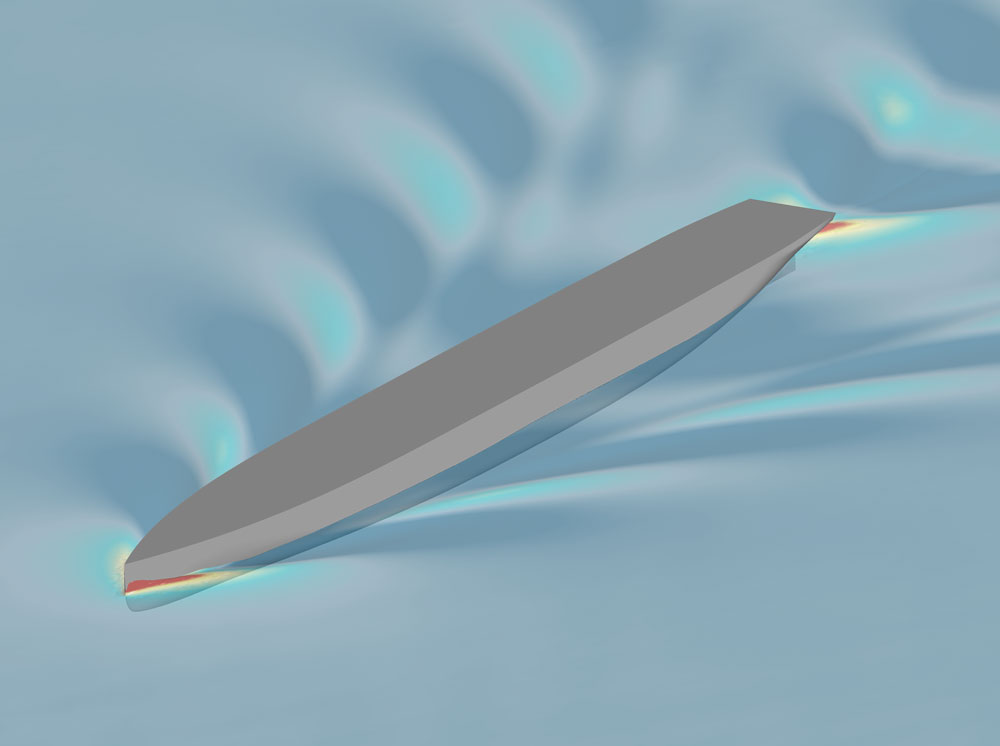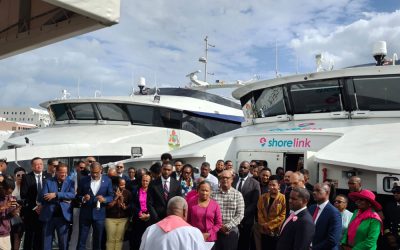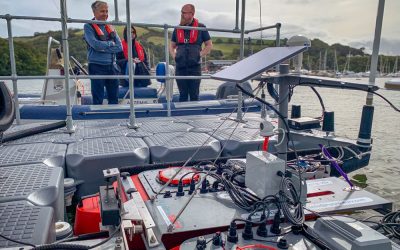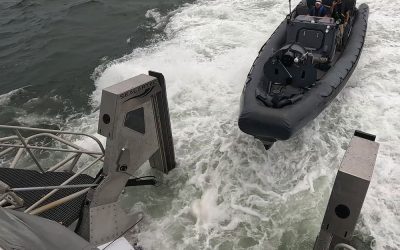The Joint Research on Ship Design Evaluation (JoRes) project is a global research initiative aimed at revolutionising the way hulls are tested for performance and efficiency, writes Dr. Shona Cunningham, principal engineer at BMT.
Traditionally, hullform designs are validated through model-scale testing in tow tanks, which involves building scaled-down versions of the hull and testing them under controlled conditions. However, this approach has inherent challenges in scaling results to full-scale due to the use of Froude number scaling as opposed to Reynolds number scaling. BMT took part in the JoRes project as, for us and our clients, one of the most important components of vessel design is understanding the total resistance of a hullform.
Dmitriy Ponkratov of JoRes and Rui Lopes of the Chalmers University of Technology brought together industry leaders to explore the feasibility of using computational fluid dynamics (CFD) for full-scale ship validation by asking participants to analyse a hull where the details of the hull were initially undisclosed until all participants had submitted their results. The purpose of the JoRes work was to carry out a ‘blind’ comparison between the unknown hull which was tested extensively at both full scale and model scale against CFD to compare the uncertainties between model scale and full scale analyses of the hullform, and discuss whether CFD calculations are viable within the cost and time-scale constraints of a commercial project.
However, it transpired we were replicating tests conducted in the 1950s by the British Ship Research Association (BSRA) on Lucy Ashton, a Clyde-built paddle steamer that carried passengers on the Clyde between 1888 and 1949, including through WWI and WWII. A significant historical connection exists, as the BSRA is one of the founding companies of what is BMT today. This historical link highlights the pioneering role of British naval research in ship design validation and underscores how we, through JoRes, continue to build on the legacy of rigorous ship performance analysis.
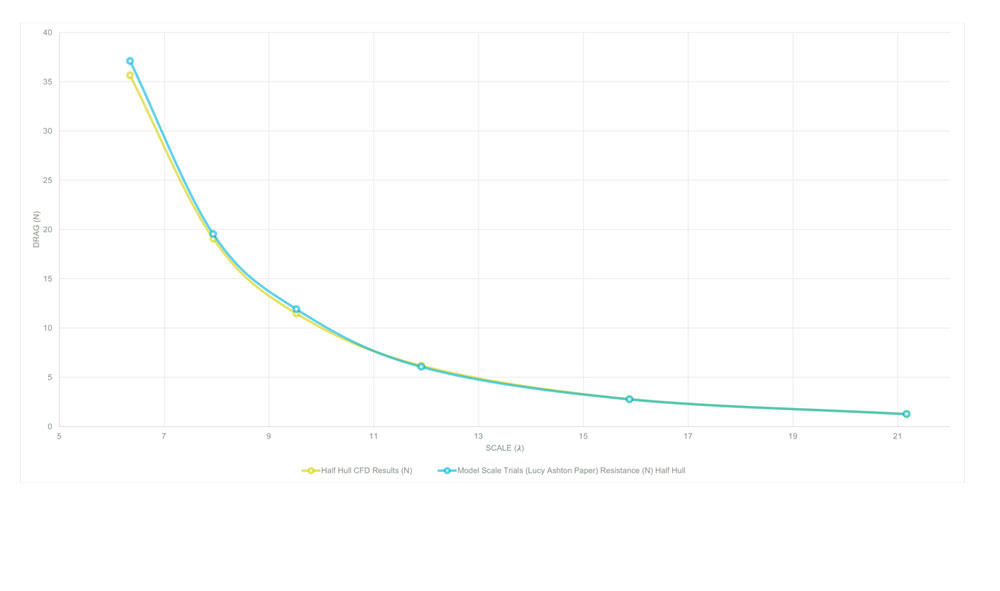
Comparison of half of the total resistance recorded for a symmetric hull from the model basin test and the CFD model scale analysis (BMT)
The results from BMT (see figure, above) and many of the other participants matched the historical data, demonstrating the accuracy of CFD for full-scale assessments. The results of JoRes reaffirm the accuracy of historical BSRA testing while showing how modern CFD approaches can enhance and potentially replace traditional model-scale methodologies. This approach could allow ship designers to assess vessels at real-world scale using advanced simulations.
Whilst the aim of this study was to provide resistance results at full scale and at six model scales, BMT went further into the analysis and used the experimental data to interrogate the scaling process, with a focus on the form factor.
Using the International Towing Tank Conference (ITTC) guidelines, the model scale results obtained from both the physical model tests and CFD simulations were scaled up. The physical model test data was scaled using the ITTC 78 (ITTC, 1978) frictional line. The form factor was calculated from the physical model tests at Froude numbers 0.1<Fr<0.2 using Prohaska’s method carried out at each scale assessed. Two ways of applying form factors were calculated for the physical model scaling process: the form factor calculated at each scale, and then one constant form factor taken from the original list. The CFD analysis calculated an individual form factor per scale using the CFD frictional line and then chose one constant form factor representative as the average to be used for all six model scale-ups.
When scaled up, the CFD results have less variability than the physical model test data. Variability is a characteristic in the experimental process with factors such as environmental effects, temperature, water quality/changes in the tank, equipment/sensors used and personnel contributing to this variability. The variability in the CFD simulation results is noticeably less as many of these factors can be controlled for. Factors affecting variability in CFD results such as the hardware, software and mesh were constant in the analysis. This contributes to a more consistent trend which is corroborated by the low coefficient of variation in the CFD results.
The results highlight the importance of the Reynolds number in the scaling process. Often when choosing the scale of model to be used in tow tank testing, the model scale used is driven by the size of the tank and thus it is often the largest beam size of the hull which is the predominant factor. The beam size must be chosen to minimise boundary effects or reflections from the tank walls. This analysis demonstrates the need for further consideration of the model scale even if it meets the beam dimension constraint.
To calculate form factor experimentally, Prohaska’s method is employed. Typically, a high scale factor corresponds to a high uncertainty. Another important scaling effect is the Reynolds number, which will cause the boundary layer of a hull to change thickness. This thickness does not change linearly with the scale factor. Therefore, the displacement thickness, pressure, and velocity profile within the boundary layer changes at varying scales. The low Reynolds number will affect the effective blockage due to the thicker boundary layer.
With improvements in technology and high-performance computing (HPC), running full-scale CFD offers an alternative solution to deriving full scale resistance results. Previously mesh, HPC and user uncertainties were primary failures of conducting full-scale CFD trials for calm resistance studies. Due to improving technology, the consistency offered by full-scale CFD arguably outweighs the uncertainties. Designs can be assessed as intended, with no unit conversions or queries on Reynolds number similarity, and now, with the conclusion of the JoRes project, validated against high-fidelity data sets.
Dr. Shona Cunningham is a principal engineer with 12 years’ experience in a consultancy role with technical responsibilities for a range of CFD projects in the fields of oil and gas, maritime, environment, civil construction and defence. Shona is a chartered engineer as well as a fellow of the Institution of Mechanical Engineers. She joined BMT as a project engineer in 2014 after receiving her PhD in Mechanical Engineering from the Cork Institute of Technology (Republic of Ireland) and her technical expertise includes CAD, data analysis, hydrodynamic analyses, gas dispersion modelling, explosion modelling, dynamic simulation models, fire and gas mapping and technical reporting.
